Who Is the Famous Artist to Do Cubism Art
The Cubism motion, which began in the early 20th century, was distinguished by the intense fragmentation, abstraction, and subdued color palette that was seen in the works made. Considered to be i of the most influential styles to come from that century, Cubism had a major touch on on the artists of that era, which led to many notable artworks beingness produced. Despite its success, Cubism was relatively a relatively short-lived movement, later leading to the emergence of Futurism, Dadaism, Constructivism, and Suprematism.
Tabular array of Contents
- one What Was the Cubism Art Motion?
- 2 Key Aspects of Cubism
- 3 Our Top 10 Most Famous Cubist Paintings
- 3.1 Les Demoiselles d 'Avignon – Pablo Picasso
- 3.ii Houses at I'Estaque – Georges Braque
- 3.3 Tea Time – Jean Metzinger
- iii.iv Man with a Guitar – Georges Braque
- 3.5 Ma Jolie – Pablo Picasso
- 3.half-dozen Nevertheless Life with Chair Caning – Pablo Picasso
- 3.7 Conquest of the Air – Roger de La Fresnaye
- three.8 Electrical Prisms – Sonia Delaunay
- iii.ix Withal Life Earlier an Open up Window, Rue Ravignan – Juan Gris
- 3.x Iii Women – Fernand Léger
What Was the Cubism Art Move?
Spanning between 1907 and 1914, Cubism developed in Paris at the turn of the 20th century equally a radical movement that broke away from the well-established traditions governing gimmicky fine art. Pioneered past notable artists Pablo Picasso and Georges Braque, Cubism developed in reaction to Picasso's shocking Les Demoiselles d'Avignon , which he painted in 1907. This led to rapid artistic experimentation being washed by both Picasso and Braque, with the latter firmly introducing the motion to the public during a one-human exhibition in 1908.
The motility was eventually given its iconic name by fine art critic Louis Vauxcelles who, upon seeing Braque's exhibited works in 1908, described them equally reducing all elements to mere outlines and cubes. Famous Cubism art highlighted the two-dimensional nature of the sheet as opposed to creating an impression of depth, which was the prior focus of artists.
This was achieved through using the aspects of perspective and tone in completely unlike ways, likewise as the creation of distinct planes to bear witness different points of view at the same time.
 Femme nue lisant (Nude Woman Reading)(1920) by Robert Delaunay; Robert Delaunay, Public domain, via Wikimedia Commons
Femme nue lisant (Nude Woman Reading)(1920) by Robert Delaunay; Robert Delaunay, Public domain, via Wikimedia Commons
Seen every bit a revolutionary new way to correspond reality, objects and people were mostly depicted from lots of different angles to the point where a kaleidoscopic view was achieved. This led to the movement beingness viewed as an advanced movement, equally artists assertively challenged Western core conceptions of graphic representation. The paintings created helped conductor in the near innovative chapter of art history that was seen at the time, equally Cubism artworks went on to instigate an accurate cultural awakening.
Picasso and Braque, in particular, felt that the worn-out standards of fine art had run their class and that an entirely new and groundbreaking motion was needed. The subsequent touch on of Cubism was far-reaching, with this geometric style existence divided into 2 singled-out phases known as Analytic and Synthetic Cubism.
Thus, despite beingness a brusk movement, Cubism proved to be highly significant based on the various offshoots that occurred, as artists displayed a great interest in this avant-garde style of fine art.
Central Aspects of Cubism
Focusing on the attribute of fragmentation, Cubist artists examined, broke up, and reassembled objects and figures in new and bathetic forms. Instead of portraying subject matter from a single viewpoint, which was the standard in traditional art, Cubist paintings made use of multiple viewpoints and then as to stand for the subject in a greater context. By displaying several points of view at the same fourth dimension, artists hinted at a possible three-dimensional nature within their works whilst too showing off the two-dimensional flatness of the sheet.
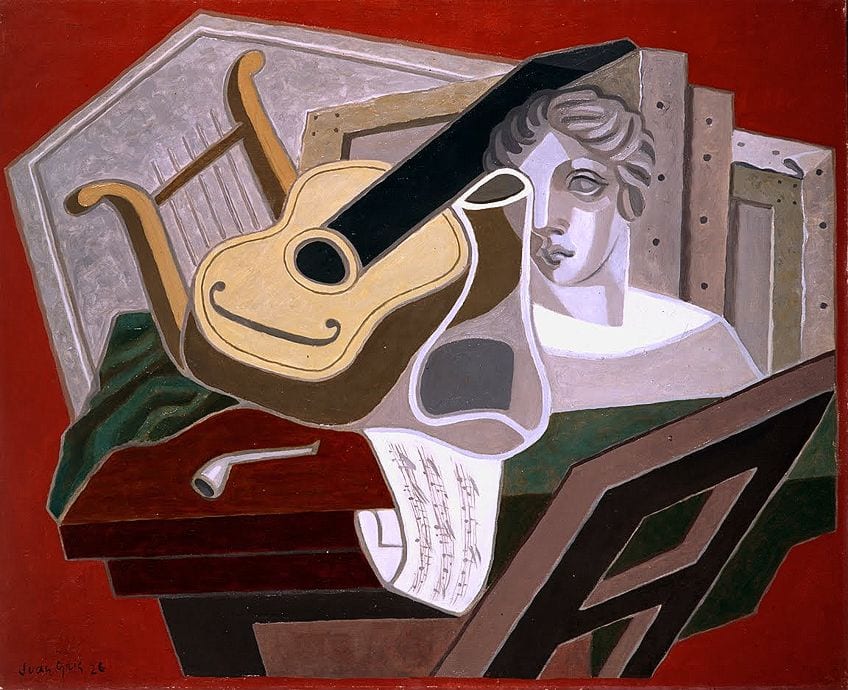 La table du musicien ( The Musician's Tabular array) (1926) by Juan Gris;Juan Gris, Public domain, via Wikimedia Eatables
La table du musicien ( The Musician's Tabular array) (1926) by Juan Gris;Juan Gris, Public domain, via Wikimedia Eatables
Every bit artists went on to develop their own blazon of terminology of cones, cubes, spheres, and cylinders, their paintings abased the element of perspective which was previously used to define pictorial infinite. In add-on to rejecting perspective, Cubism artists portrayed and manipulated light and shadows in a diverseness of means then every bit to effectively break downwardly objects into several apartment planes.
When viewing Cubist paintings, no realistic scenes were portrayed every bit artists chose to explore the space in which the figures and objects existed instead.
Another important attribute of Cubism was the emphasis placed on architecture, structure, and form. These two elements were crucial within Cubist paintings, as a very analytical and geometric approach was taken when representing subjects in these works. Rather than being formed to fit into an illusionistic space, figures and objects were portrayed equally dynamic and lively compositions made upwards of volume and planes. This allowed the background and foreground in Cubism paintings to merge, which was seen as very futuristic at the time.
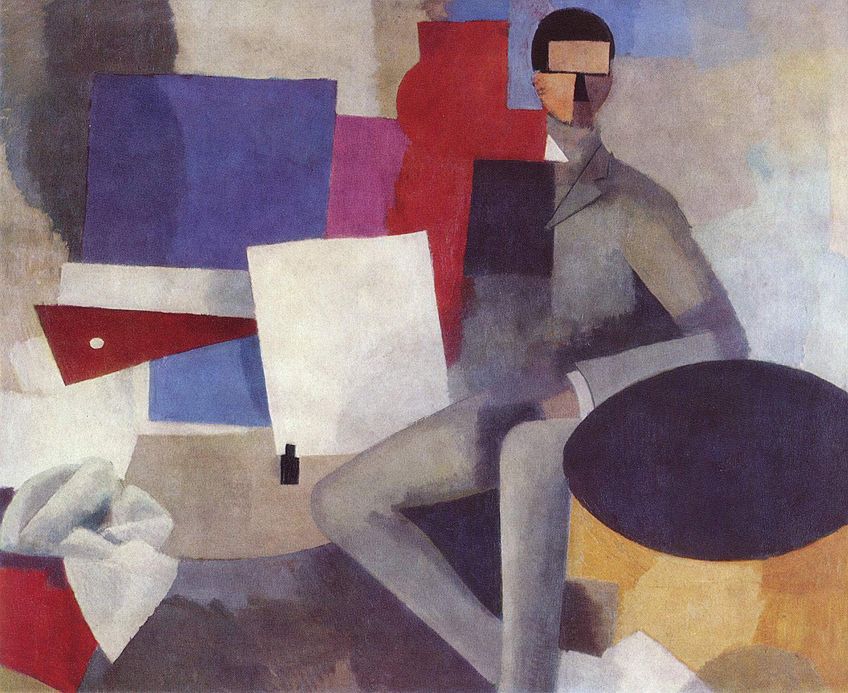 Homme assis (Seated Human being)(1914) by Roger de La Fresnaye; Roger de La Fresnaye, Public domain, via Wikimedia Commons
Homme assis (Seated Human being)(1914) by Roger de La Fresnaye; Roger de La Fresnaye, Public domain, via Wikimedia Commons
As Cubism directly challenged the Renaissance's depiction of space, many artists experimented with the idea of not-representation in the paintings that were produced. This even led artists to incorporate elements of collage and sculpture into their paintings, which was almost notably demonstrated past Pablo Picasso and Georges Braque. Picasso fabricated use of sculpture in his Maquette for Guitar (1912), while Braque is widely considered to have produced the very get-go newspaper collage in his Compotier et verre (fruit dish and glass) (1912).
Our Top 10 Most Famous Cubist Paintings
Despite only lasting seven years, Cubism proved to be an incredibly influential movement, as seen by the paintings that were produced during its peak. While many artworks were made, a scattering has managed to stand out as truly iconic Cubism paintings. Often produced by the same creative person, these paintings were created by several painters who emerged as the leading pioneers of the motion.
Below, nosotros will be going through our list of the top ten most famous Cubism art pieces to exist.
Les Demoiselles d 'Avignon – Pablo Picasso
| Creative person | Pablo Picasso |
| Appointment Painted | 1907 |
| Medium | Oil on canvas |
| Dimensions | 243.nine cm x 233.seven cm (96 in ten 92 in) |
| Where Information technology Is Currently Housed | Museum of Modern Art, New York Metropolis |
Out of all the paintings that Pablo Picasso produced during his career, Les Demoiselles d 'Avignon exists as an iconic slice. Painted in 1907, just every bit the Cubism move began, this painting shocked the public and Picasso's close friends due to its unusual content and formal experimentation. With the subject matter consisting of stylized and seemingly abstracted nude women, Picasso demonstrated his involvement in baloney and the bang-up influence that African art had on his painting technique.
What stunned audiences near this painting was non the nudity that was shown merely the fact that Picasso chose to portray these women every bit prostitutes in aggressively sexual poses. This was a novel thought at the time, every bit subjects of this nature were by and large non depicted inside traditional art club. The blatant sensuality seen within Les Demoiselles d 'Avignon was farther highlighted by the mask-like faces of the women, which unsaid that their sexuality was incredibly primitive in addition to beingness hostile.
Distinct features of Cubism were seen through the unusual elements and sharp contrasts created past the bodies, which all added to its daze value.
Picasso abandoned the concept of depth inside this painting, as he presented a drastically flattened picture show that was cleaved up into geometric fragments making up the women's bodies. By abandoning all accepted forms governing traditional art, Picasso pioneered using unusual geometric shapes to portray the man form, making Les Demoiselles d 'Avignon the near famous case of Cubism.
Houses at I'Estaque – Georges Braque
| Creative person | Georges Braque |
| Date Painted | 1908 |
| Medium | Oil on canvass |
| Dimensions | forty.5 cm x 32.five cm (15.9 in x 12.7 in) |
| Where It Is Currently Housed | Museum of Fine Arts, Bern |
An important work in the foundation of Cubism was Houses at I 'Estaque, painted by Georges Braque in 1908. The artworks produced by Braque betwixt 1908 and 1912 so closely resemble that of Picasso's, that their Cubism paintings were oftentimes indistinguishable. Houses at I 'Estaque inspired the name of the movement, equally art critic Louis Vauxcelles commented that Braque reduced every element within this painting to mere "cubes", which came to be later on known as Cubism.
Inside this painting, Braque demonstrated noticeable influence from Picasso through his extreme reduction of class and the apply of geometric shapes to ascertain objects.
Just painting the outside of houses and their surrounding mural, Braque overlapped the object and groundwork to the indicate where both aspects fully occupied the entire foreground of the canvas. Due to the flat and level spacing, no horizon line or vanishing point could be seen within Houses at I 'Estaque, which farther added to the ii-dimensionality of the work.
Additionally, the shading used past Braque was extremely untraditional, equally it made no effort to add whatever depth and perspective to the objects. When because this famous Cubism fine art piece, Braque's decision to break imagery into dissected parts became clearer, with the subtle and earthy color palette further separating the different elements in his work. While there is debate as to whether Houses at I'Estaque tin be seen as the offset Cubist mural, the elements within this painting went on to form the footing of the Cubist style.
Tea Time – Jean Metzinger
| Creative person | Jean Metzinger |
| Engagement Painted | 1911 |
| Medium | Oil on cardboard |
| Dimensions | 75.9 cm ten 70.ii cm (29.8 in 10 27.vi in) |
| Where It Is Currently Housed | Philadelphia Museum of Art, Philadelphia |
Jean Metzinger was known for bringing Cubism to the attending of the public during the movement's time, with his paintings extending more to the advanced side of the manner. His 1911 painting, titled Tea Time, was i of his about well-known works from the motion, every bit it afterward went on to exist known as "The Mona Lisa of Cubism". Portraying a seated woman holding a teaspoon hanging between her cup and oral fissure, Metzinger made use of various Cubist techniques to create an entirely fragmented representation of a figure.
 Portrait photograph of French Cubist painter Jean Metzinger, 1912;Pierre Choumoff, Public domain, via Wikimedia Commons
Portrait photograph of French Cubist painter Jean Metzinger, 1912;Pierre Choumoff, Public domain, via Wikimedia Commons
What makes Tea Fourth dimension ane of the more interesting Cubist paintings is that while other artists were working towards the dematerialization of figures, Metzinger demonstrated a commitment to achieving some form of precision and distinctness within this painting. Despite making utilise of irregular shards and planes to depict a woman, the subject matter within Tea Time is instantly recognizable at first glance, despite its geometric environment.
The about discussed aspect of this painting is the split focus that Metzinger used to depict the teacup and the woman'southward face.
Abandoning the single signal of view that was pop during the Renaissance, the teacup was seen in profile and from directly in a higher place, then as to demonstrate the new techniques of Cubism. Despite these different perspectives, Metzinger achieved a startling level of realism despite the piece of work being made up of aberrant shapes and angles, with the softer colors used placing more emphasis on the nude female effigy sipping tea.
Human being with a Guitar – Georges Braque
| Artist | Georges Braque |
| Engagement Painted | 1911 |
| Medium | Oil on canvas |
| Dimensions | 116.two cm ten 80.nine cm (45.7 in ten 31.9 in) |
| Where It Is Currently Housed | Museum of Modern Art, New York Urban center |
Another significant Cubist painting past Braque is his Man with a Guitar, painted in 1911. Considered to exist his most influential piece of work, it formed office of the Analytic Cubism period, as Braque challenged the concept of illusionistic space within the work. In club to create this artwork, Braque rendered nails and ropes on a sheet to depict the outline of a man busy playing guitar. However, the outcome of Braque'south technique was a nearly indecipherable portrayal of a man, as the focus of the work savage on the jagged and intersecting cubes.
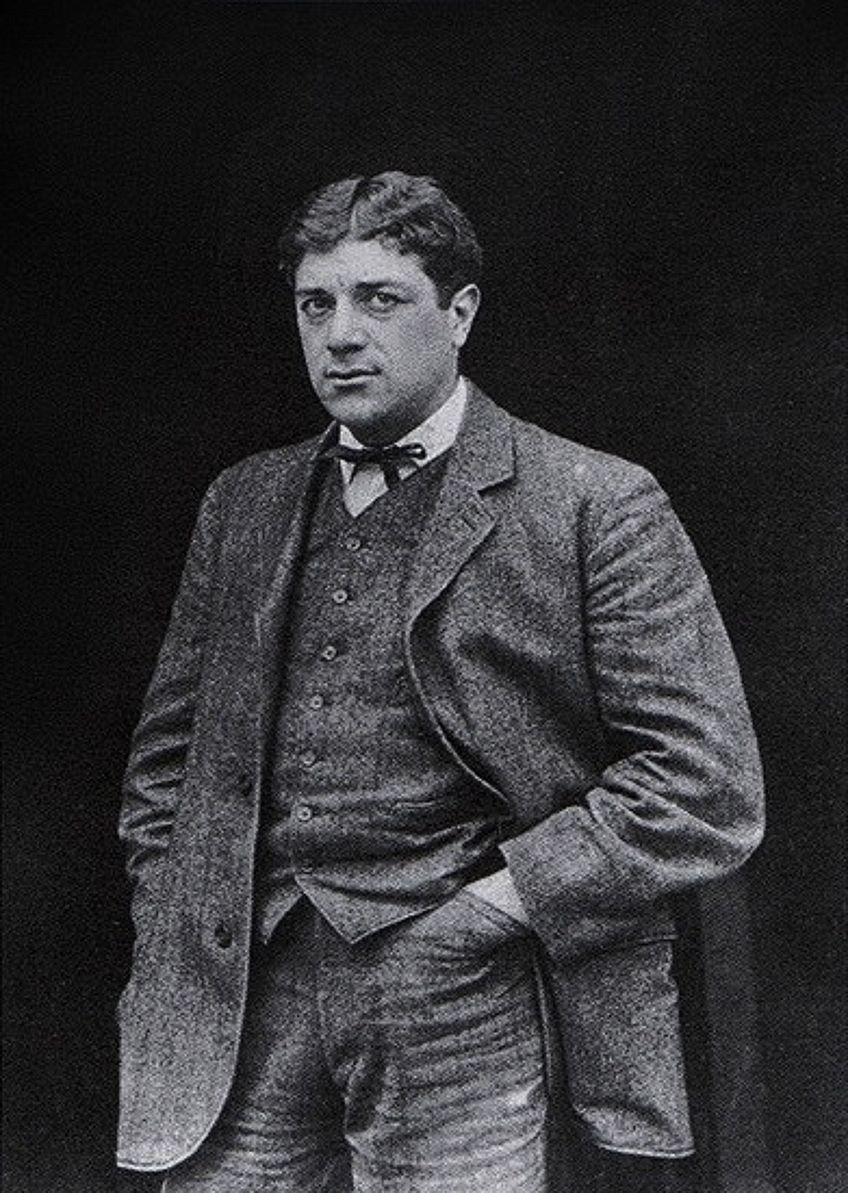 Photograph of Georges Braque, 1908;Lensman non-identified, anonymous, Public domain, via Wikimedia Eatables
Photograph of Georges Braque, 1908;Lensman non-identified, anonymous, Public domain, via Wikimedia Eatables
Noted by the majority of critics and viewers to exist barely recognizable, Human being with a Guitar is instead appreciated for the spatial elements that can be seen. Due to this, the painting is considered to exist a masterpiece that has the ability to play on the human being mind in the same way that a musician would strum a guitar. Within this work, Braque disputed the long-held view that art had to stick to certain shapes and forms, with Man with a Guitar purposefully challenging viewers to make sense of the vaguely depicted angles, shades, and tiny details.
When viewing this work, many take stated that information technology appears to be ever moving.
Equally it was a busy painting, each aspect demanded a significant amount of attention to be properly inspected, so that the pregnant of the piece of work could go clearer. By ignoring the conventional use of perspective, Braque was able to claiming viewers to try and understand a painting that had been cleaved downward to its virtually basic geometric elements.
Ma Jolie – Pablo Picasso
| Artist | Pablo Picasso |
| Engagement Painted | 1911 – 1912 |
| Medium | Oil on canvass |
| Dimensions | 100 cm x 64.five cm (39.4 in 10 25.4 in) |
| Where It Is Currently Housed | Museum of Modern Art, New York City |
1 of the other pop Cubist paintings created by Picasso between 1911 and 1912 was Ma Jolie, which translated to "my pretty daughter" in English. Inspired subsequently watching a musical performance of the same name, Picasso nicknamed his lover, Marcelle Humbert, Ma Jolie and went on to depict her in this painting. Vaguely building her figure up in this artwork through using signature shifting planes made famous by Analytic Cubism, Picasso created a portrait that did not resemble a person at all.
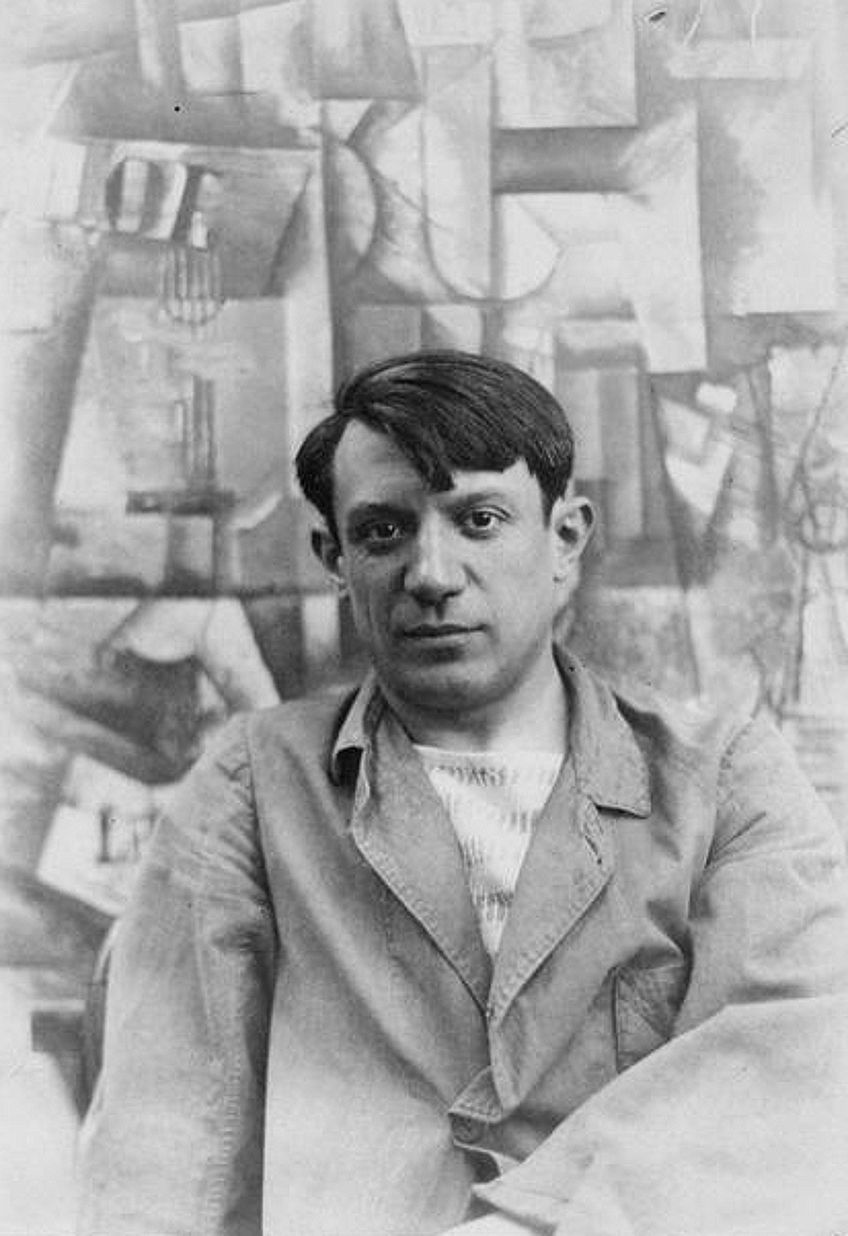 Portrait photograph of Pablo Picasso, in front end of his painting The Aficionado (Kunstmuseum Basel) at Villa les Clochettes, Sorgues, French republic, summertime 1912; Anonymous Unknown writer, Public domain, via Wikimedia Commons
Portrait photograph of Pablo Picasso, in front end of his painting The Aficionado (Kunstmuseum Basel) at Villa les Clochettes, Sorgues, French republic, summertime 1912; Anonymous Unknown writer, Public domain, via Wikimedia Commons
Within this work, Picasso congenital upon overlapping and geometric shapes to create an extremely fragmented representation of a person, with the loose outline of the strings of a guitar being institute in the middle of the composition. Moving in the direction of abstraction, Picasso express his color palette in Ma Jolie so as to create the impression of a low-relief sculpture, further accentuated past the light and dark tones of the cubes.
The angular shapes and their dreary colors seem to limited a deeper meaning, as the central figure all but vanishes into the depths of the work.
Building on his previous Cubist paintings, Picasso demonstrated a more blatant motion towards fragmentation and brainchild through the muted colors that are juxtaposed against the seemingly assertive shapes. Thus, despite being intended as a portrait, Ma Jolie represents Picasso's move to a more non-representational context, equally no discernable image tin can exist made through the network of cubes and athwart lines.
Yet Life with Chair Caning – Pablo Picasso
| Artist | Pablo Picasso |
| Date Painted | 1912 |
| Medium | Oil on oilcloth over canvas edged with rope |
| Dimensions | 29 cm x 37 cm (11.4 in x 14.6 in) |
| Where Information technology Is Currently Housed | Musée Picasso, Paris |
The terminal painting on our list by Pablo Picasso is his Still Life with Chair Caning, which was produced in 1912. Idea to be one of the almost easily recognizable pieces from the Cubism movement, this artwork is historic for being seen equally mod art's offset-ever collage slice. Inside this artwork, Picasso worked to reintroduce colour to his art and went on to experiment with multiple perspectives. Attaching several objects to his sheet, Picasso incorporated a playful yet clear intention with this artwork, as it was made to resemble a chair.
When looking at Still Life with Chair Caning, the paradigm of a café tabletop comes to mind. Objects such as pieces of fruit, vino glasses, and knives can be seen from diverse viewpoints in the tiptop correct of the artwork, which were depicted by Picasso through both paint and collage. While the chair caning seen in the bottom was fabricated from a slice of printed oilcloth as opposed to an bodily piece of caning, the rope surrounding the sheet was existent.
Through using a found object, its purpose was to suggest the carved border of a café table for viewers.
Every bit the only printed words within Still Life with Chair Caning, "JOU" acts as a focal betoken in the artwork. Its inclusion was thought to spell out the first three letters of the French give-and-take for newspapers, as Picasso attempted to refer to the human activity of reading that was more often than not done at Parisian cafés. Existing as the offset artwork to incorporate collaged elements into a piece of work of loftier art, Still Life with Chair Caning referenced the volatile and precarious political state of affairs in Europe at the fourth dimension, as well as Picasso'southward own revolutionary inclinations.
Conquest of the Air – Roger de La Fresnaye
| Artist | Roger de La Fresnaye |
| Date Painted | 1913 |
| Medium | Oil on canvas |
| Dimensions | 235.nine cm ten 195.half-dozen cm (92.8 in x 77 in) |
| Where It Is Currently Housed | Museum of Mod Art, New York City |
One of the other well-known Cubism artists was Roger de La Fresnaye, who painted the iconic Conquest of the Air in 1913. Considered to exist one of the about memorable Cubist paintings in existence, this work proved to exist incredibly popular among French artists at the time.
This was because La Fresnaye's brilliant and optimistic paintings helped popularize Cubist portraits and paintings before the start of World War 2.
Within Conquest of the Air, La Fresnaye portrayed himself with his blood brother, Henri, sitting at a table exterior. In the distant groundwork in the acme left corner, a xanthous hot-air balloon can be seen. This was thought to reference the Gordon Bennet cup, which was the oldest balloon race in the world at that fourth dimension. In 1912, a French grew won the race, which explains the inclusion of the slightly fragmented but celebratory French flag on the right-manus side of the sheet. By using cleaved-up blocks to brand upward the flag, La Fresnaye added the element of motion to the material, every bit the flag appears to exist blowing gently in the wind.
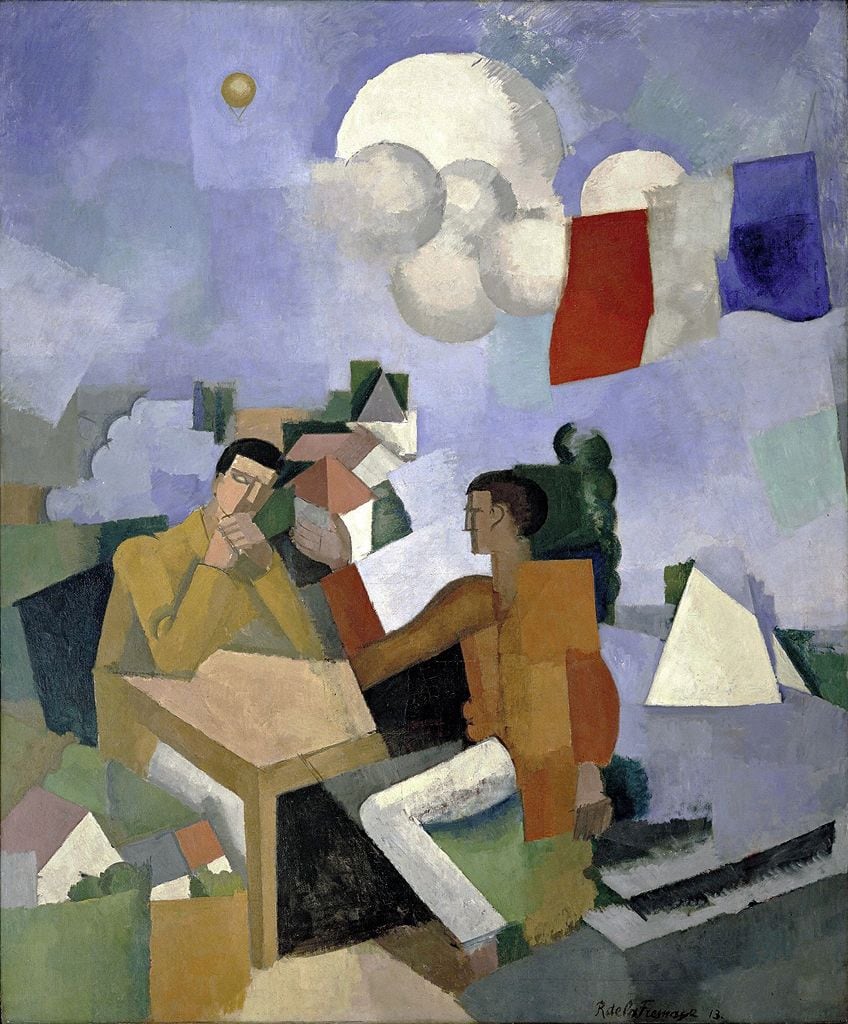 La Conquête de 50'Air (Conquest of the Air)(1913) by Roger de La Fresnaye; Roger de La Fresnaye, Public domain, via Wikimedia Commons
La Conquête de 50'Air (Conquest of the Air)(1913) by Roger de La Fresnaye; Roger de La Fresnaye, Public domain, via Wikimedia Commons
Showing influences from both traditional Cubism and Orphism, developed by fellow artist Robert Delaunay, La Fresnaye depicted the figures inside his piece of work using vivid and colorful geometric shapes. A circular experience tin can be seen through the placement of the shapes in the eye of the canvas, which lent itself nicely to the characteristics of Orphism.
This painting played upon the conventionalities that every natural element adhered to vague geometric perfection, as every aspect inside this painting was depicted by sharp and triangular qualities.
Electric Prisms – Sonia Delaunay
| Artist | Sonia Delaunay |
| Engagement Painted | 1914 |
| Medium | Oil on canvas |
| Dimensions | 250 cm ten 250 cm (98.4 in x 98.4 in) |
| Where Information technology Is Currently Housed | The Centre Pompidou, Paris |
Another exceptionally colorful famous Cubism art piece was Electric Prisms, which was painted by Sonia Delaunay in 1914. Along with her married man, notable artist Robert Delaunay, she adult a completely not-objective fashion of fine art which somewhen transformed itself into a mixture of Postal service-Impressionism and Fauvism. Delaunay's innovative explorations with vibrant colors were fully realized in Electrical Prisms, as information technology exists as a meticulous example of how she was able to combine her signature and colorful mode with the ideals of Cubism.
Considered to be a chiliad celebration of colour, the focus of Electric Prisms is around the ii large and overlapping circles. These were substantially created past curves of primary and secondary colors placed beside one another, while the residual of the sheet was covered in a multifariousness of other colors and shapes. Abstracted forms such every bit rectangles, arcs, and ovals are joined together to form a mixture of tones, as each fragmented shape carries the connotation of being sewn together, just like a tapestry.
Within Electric Prisms, Delaunay demonstrated her fascination with geometric forms and flattened perspective. However, this Cubist artwork also showcased her abstract involvement in colour and concept, as her brilliant blocks of paint went on to suggest that a possible time was visible the longer one stared at the piece of work.
Said to be representative of the dynamic movement of electricity, Delaunay was inspired to capture the striking glow of light after viewing the new electric laps along the boulevard Saint-Michel in Paris.
Yet Life Before an Open up Window, Rue Ravignan – Juan Gris
| Artist | Juan Gris |
| Date Painted | 1915 |
| Medium | Oil on sheet |
| Dimensions | 115.9 cm x 88.9 cm (45.6 in x 35 in) |
| Where It Is Currently Housed | Philadelphia Museum of Art, Philadelphia |
An artist whose Cubist paintings were often considered to be closest to that of Picasso and Braque was Juan Gris, who painted the well-known Notwithstanding Life Before an Open Window, Rue Ravignan in 1915. Painting with vibrant and uniform colors in contrasting combinations, this artwork combined Gris's interest with indoor and outdoor views on the same canvas. Through blending scenes from the interior and exterior, Still Life Before an Open Window, Rue Ravignan exists as a groovy example for Cubism artworks through the techniques used.
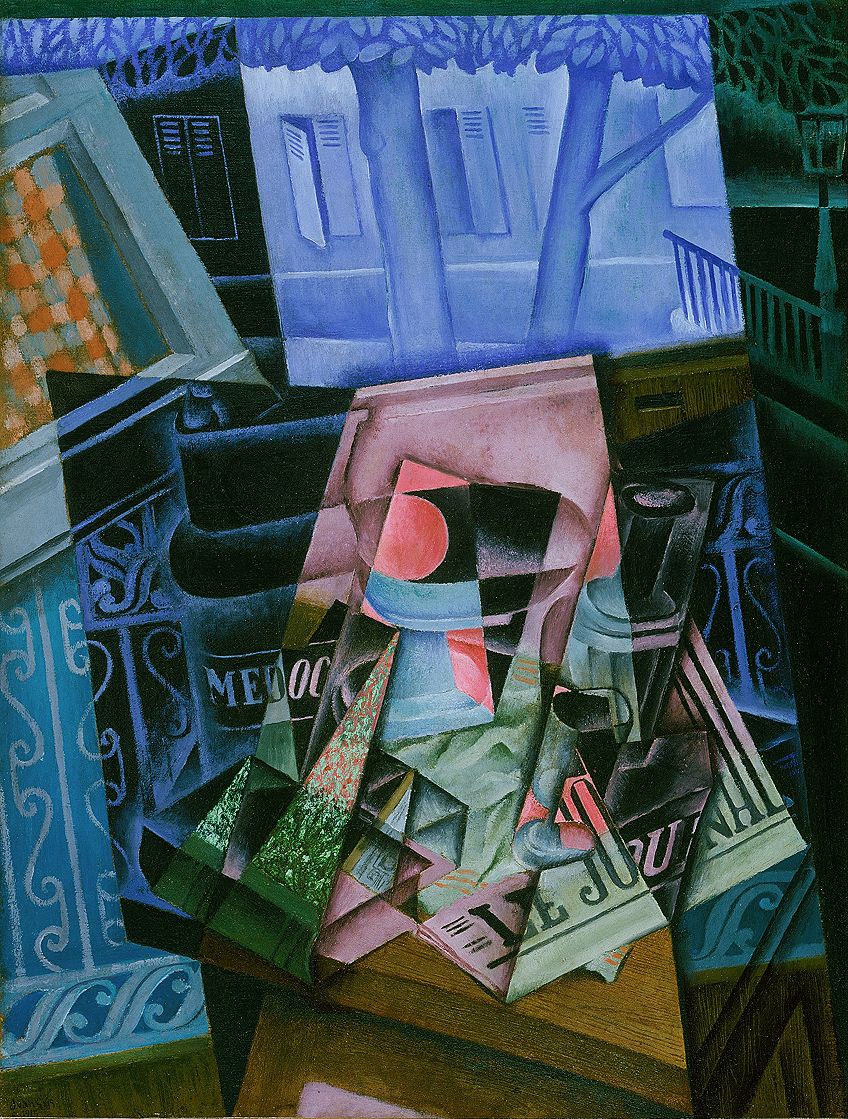 Even so Life before an Open up Window, Place Ravignan(1915) by Juan Gris;Philadelphia Museum of Fine art, Public domain, via Wikimedia Commons
Even so Life before an Open up Window, Place Ravignan(1915) by Juan Gris;Philadelphia Museum of Fine art, Public domain, via Wikimedia Commons
According to the artwork's title, it featured some traditional objects associated with still life, such equally a bowl of fruit, a bottle and glass, every bit well equally a book and newspaper. Represented by the most colorful section on the sail, these objects were shown to be carefully bundled on a table at a balcony window. Additionally, this fragment of the painting appeared to be lite up past the moonlight coming in from outside, which was implied by the blueish squares depicting an exterior scene.
While the subject matter in Nonetheless Life Before an Open up Window, Rue Ravignan might have been common and unsurprising, its abstract arrangement was incredibly innovative. Gris was more artful than any of the other Cubist artists at the time, equally his structured grid of overlapping planes created a delicate balance and counterbalance between the different areas of the canvass.
Effortlessly irresolute between low-cal and dark, positive and negative, as well as monochrome and color, Gris' entire work was considered with a blazon of classical precision.
Three Women – Fernand Léger
| Artist | Fernand Léger |
| Engagement Painted | 1921 |
| Medium | Oil on canvass |
| Dimensions | 251.five cm x 183.5 cm (99 in x 72.ii in) |
| Where It Is Currently Housed | Museum of Modernistic Art, New York City |
The final famous Cubism art painting that we have included on our list is Three Women, which was painted past Fernand Léger in 1921. Produced a while later on the Cubism movement had concluded, this artwork offered a more upwardly-to-engagement image of a time-honored subject within fine art history, which was the reclining female nude. Demonstrating influences from both Cubism and Futurism in this painting, Three Women provided a modernistic vocabulary to accompany the nude grade.
 Portrait photo of Fernand Léger, 1936;Carl Van Vechten, Public domain, via Wikimedia Commons
Portrait photo of Fernand Léger, 1936;Carl Van Vechten, Public domain, via Wikimedia Commons
Based on Cubist aspects, Léger depicted three figures drinking tea or java and lounging around in a very mod flat by using solid geometric forms. Withal, the immaculate colors that were used in the shapes lent themselves to Analytic Cubism, every bit they do non overlap in the foreground but rather assist in the creation of a type of three-dimensionality. Due to this, the bodies of the women, the furniture they sit down on, as well equally the spaces between them appeared incredibly well defined and easily distinguished.
Despite the nude existence a common subject throughout most of art history, Léger'due south figures were more polished and refined than whatever figures that were seen in other Cubist portraits. These seemingly elegant figures demonstrated a return to order and normality, which was a pervasive theme in French art after the turmoil of the Second Earth State of war. Using a precision that was likened to a automobile, Léger presented simplified women that were rounded and completely dislocated from reality, which stood equally a symbol for the modernistic world then.
Cubism proved to exist one of the near prolific art movements of the 20th century, with both Picasso and Braque working together to fully establish and spread the ethics of the mode. Therefore, many artworks are thought to be peachy examples of Cubist paintings, with our list higher up capturing the most well-known paintings of the fourth dimension. If you lot have enjoyed reading about these artworks, we encourage you to explore other Cubist artists and their iconic works, as many notable Cubist portraits and paintings exist.
Have a look at our Cubist paintings webstory hither!
Source: https://artincontext.org/famous-cubist-paintings/
0 Response to "Who Is the Famous Artist to Do Cubism Art"
Post a Comment